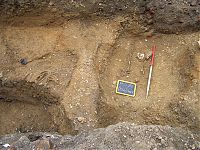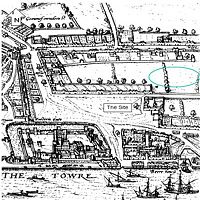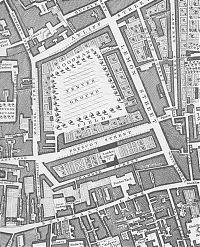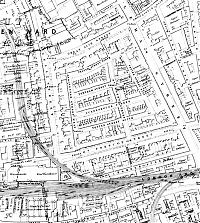Introduction
The site was evaluated in 2006 by L – P using the site code PCO06. 5 archaeological evaluation trenches were excavated on the Prescot Street site during March and April 2006. The aims of the evaluation were twofold: to understand the nature, survival and extent of archaeological remains on site, and to fulfill thematically based research aims relating to the existence, extent and function of different archaeological phases on site, and how they relate to the changing use of the Prescot Street site over time. The results of the evaluation gave a good indication of the type and extent of archaeology that survives on the site, and the levels at which they survive. The archaeology that survived can be dated to four main periods:
Roman
The evidence for Roman use of the site comes from densely packed inhumation and cremation burials, quarry pits and ditches that relate to the East London Roman cemetery. The burials and ditches align with the cemetery road that runs east – west past the site, as seen in other areas of the East London Roman cemetery. Deposits of charred lentils and other pulses, hazelnuts and cereal grains were found in association with the cremated bones, and may represent funerary offerings. Similar deposits have been found in other areas of the East London Cemetery. Animal bones were found in such small quantities that suggest that rubbish dumping was taking place rather than ritual deposits relating to burial practices.
Early Post-Medieval
The evidence from the desk based assessment of the maps and archaeological evidence during the evaluation suggests that the area was open land during the late Medieval to Early Post-Medieval period. However, the site seems to have been used for rubbish dumping in this period. Animal bones from this period include a very young piglet and lamb, which suggests that sheep and pigs were kept or bred in the area. There is evidence for the deliberate disposal of rubbish. Items such as the leather offcuts, spindle and an assemblage of animal and fish bone, eggshell and marine mollusc that suggests food processing and domestic cooking, indicates the dumping of household and perhaps light industrial waste.
Late Post-Medieval
Prescot Street was first developed during the period 1680 to 1745. This development seems to have been part of a large scale property speculation. The ‘urban plan’ was to construct a square of four wide avenues surrounding a central square or garden. The houses on the avenues were of a very high standard, with contemporary maps showing large gardens expanding northwards over the site. A small collection of horn cores used as construction material were found in Trench 3. This is a common building material in East London, and probably indicates the presence of a local hornworking workshop, an industry commonly based in this part of London in the mid-17th century, espcially in the Middlesex Street/ Brick Lane area.
19th Century Redevelopment
As London grew during the later part of the 18th and 19th centuries, the Aldgate area changed in character. The large gardens at the rear of the Prescot Street houses are built over in an ad hoc fashion and the central square is also laid out for small streets and buildings. We can also imagine that Prescot Street was occupied more densely, perhaps with larger extended families in the houses. The evidence from the evaluation indicates that the basements of these buildings sealed the archaeology in most places. The final phase of destruction of the buildings on site seems to date to the Second World War, with only 3 or 4 buildings surviving into the 1970s.
- By: Lorna Richardson |
- Nov 15, 2007
- Share



